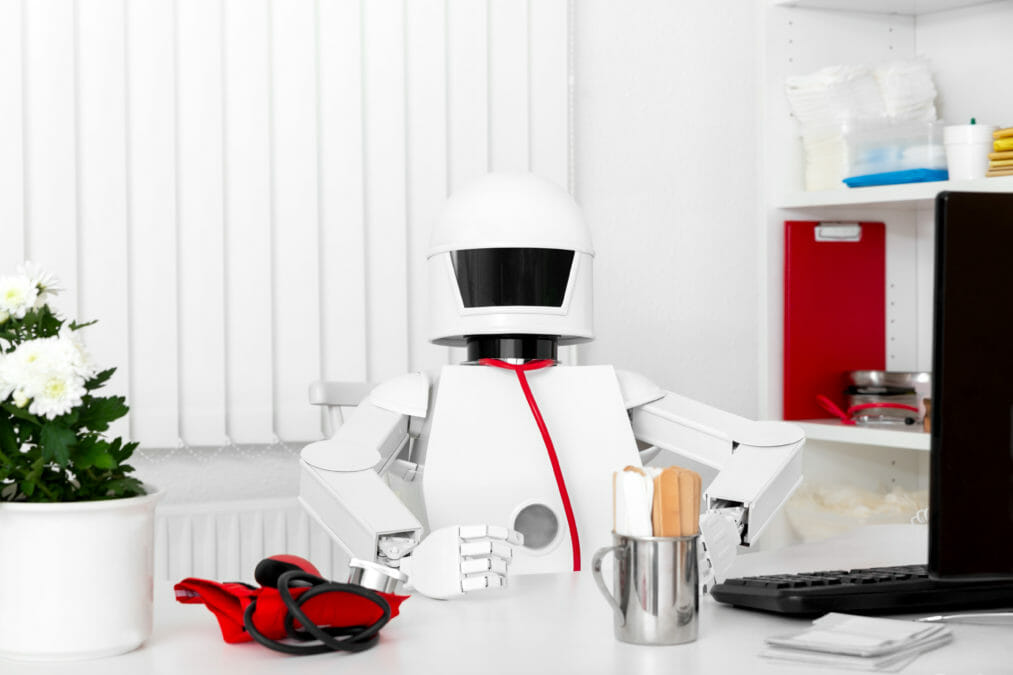The headline is stunning, the detail reveals nuance. A new report in The Lancet Digital Health Journal finds that deep learning could correctly detect a disease 87% of the time, compared to 86% for healthcare professionals. So is it curtains for doctors, then? Drill down and talk to professionals and you find that there is more to it than that. AI is flawed, deep learning is not infallible, but human and machine together, now that can give healthcare the, errr, well the shot in the arm.
How IoT – and IoMT – is changing the face of medicine and healthcare today
Truth is, there is probably too much talk about AI taking jobs away from humans and not enough on what a formidable partnership human and machine working in healthcare could be.
Take another report. A new ultrasound technique is about to begin trials. The researchers, from Heriot-Watt University in Edinburgh, behind the new technique, say it will be ten times better than existing scans at spotting early signs of cancer. The ultrasound technique entails super-resolution images, the science of microbubbles and advanced statistical techniques using computer power.
There is no mention of AI, but computer power that was unavailable until quite recently is the key.
Without computer power, the technique would not be possible, without humans and machine working together, it would not even be a vague possibility.
Returning to the report suggesting AI can match humans in medicinal diagnosis. There is a problem, it only used 14 studies to inform the report out of a possible 200,000.
As Björn Brinne, Chief AI Officer at Peltarion said: “Despite the varying quality of AI research noted in the report, we can’t overlook the great progress that’s been made in deep learning in healthcare and the potential it has to augment human skills. Real-world use cases are emerging which will help with everything from diagnosis to treatment, such as this recent study that used deep learning to diagnose Celiac disease in Children with 93.4% accuracy. If deep learning can be – as the report says – “as good” as doctors in terms of accuracy, it has the potential to greatly improve patient care by taking the pressure off understaffed hospitals and ensuring doctor’s time is used in the best way.”
Digital integration of healthcare means empowering patients and clinicians
Human-machine collaboration in healthcare
Julien de Salaberry, the CEO and co-founder of Galen Growth Asia intelligence, analytics and matchmaking firm in Asia Pacific said that “with the current pace of machine learning developments, we can probably assume that in less than 10-years time, algorithms will exceed humans in the majority of today’s diagnosis.
“Over the past five-years, we have seen error rates on speech and image recognition drop by over 20% to nearly human accuracy. So we should expect algorithms to out-perform humans in specific tasks such as diagnosing disease.
“For example, in radiology and more specifically mammography screening, an algorithm trained to identify Metastatic Breast Cancer, interpreting pathology images, reached an accuracy of 92.5%, where pathologists reached an accuracy of 97%. However, when used in combination, the detection rate neared 100%.
“It is going to be the collaboration between humans and machines that is going to play a vital role in the age of AI. I am not sure the current generation of healthcare professionals are ready or equipped for such an age.”
Augmented intelligence is a better option than artificial intelligence
Dr. Anushka Patchava Digital Health Strategist for AI and Blockchain in Healthcare puts emphasis on augmented intelligence — human and machine working in healthcare, augmenting humans.
She told Information that “although [the study marks] a positive step, demonstrating the potential for augmented intelligence to assist clinical decision making and clinician workload, there are still unanswered questions prior to large scale adoption.
“For example, in actual diagnostic situations, the existence of ‘unidentified’ objects which may not be in the training data (e.g. foreign bodies, aberrant or rare tumours) could exist. With convolutional neural networks these would be forcibly categorised into a pre-defined category – compromising accuracy, and potentially leading to incorrect classifications by machine – and poor outcomes for patient.
“We need to embrace the utilisation of artificial intelligence in healthcare with caution. Key to the success of such, is the broad, diverse data sets (the study attempts to do so using multi-geographical data from Pakistan, Zambia and United States) we use to build the machine learning algorithms in the first place – and the human safety gates we include in the process so that it’s ‘augmented intelligence’ guided by human insight and best practice that delivers value to system and patient.”
Robotic process automation in healthcare will lead to better patient outcomes
The NHS challenge
Björn Brinne added: “The report is correct that there are a number of urgent challenges that need to be addressed. Many deep learning projects to date have been focused on small pockets of research, which presents issues in relation to repeatability, auditability and scalability which are needed to make a global impact. Also, lack of skills, cost and complexity remain as barriers.
“For the NHS, this is a major challenge as budgets and talent are already limited.
“There’s also the data issue – deploying deep learning models in the health sector requires retraining them when new data comes in, a complex and often costly task.
“Additionally, to begin with, the quantity of data available will be limited and the quality of it inconsistent, which could lead to inaccuracies. There are also obvious challenges in the sensitivity of the data that is needed and requirements for consent.”
“In order to overcome these challenges, deep learning needs to move away from being used as a research tool, and instead become operationalised to make outputs more robust and usable. This will make deep learning accessible for a wider group of users in the medical industry, so that data pools become greater and more varied over time, improving model performance and, by extension, the quality and effectiveness of patient care.”
Laying the foundations to future-proof our NHS and power UK HealthTech
The NHS and automation
Ian McGregor, vice president of sales at robotics process automation company, UiPath, with responsibility for assisting the NHS to adopt new technologies, said: “AI and automation both have huge potential to bring change and benefits to the industry, and will ultimately improve the quality of patient care and the working lives of all the dedicated healthcare professionals.
“With our much-loved and much-beleaguered NHS under constant pressure to deliver more with fewer resources, AI and robotic process automation (RPA) can help free up crucial resources – increasing value-based patient care at lower costs and increased efficiency.
“This message very closely echoes the message of Nick Hancock’s speech at NHS Expo 18. However, we are still at the beginning of this exciting and innovative journey. According to the management consultancy group McKinsey, healthcare has a 36% automation potential, but only 10% of the NHS’ 90% automatable processes have yet been automated. Technology can help create a more efficient healthcare system, with benefits being felt by millions across the country.”
Data and AI can’t bring the NHS back into rude health, but machine and human, given time, advances in AI and Deep Learning, can be transformative.
How AI is revolutionising healthcare: 10 use cases of artificial intelligence in healthcare
Healthtech valuations reach five year high
AI neural network health-tech tool may solve health tech IP/collaboration dilemma
AI in healthcare: Can AI solve the health tech puzzle of new drug discovery?
AI and machine learning needed to improve the healthcare industry
What is the potential of artificial intelligence in healthcare?
How cloud technology is transforming the healthcare industry







